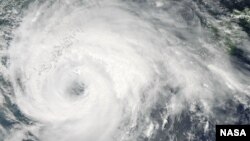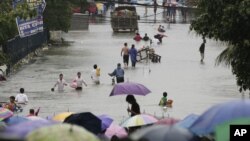Residents of Shanghai and other cities along China’s east coast are taking shelter as authorities have ordered mass evacuations to prepare for the region’s third typhoon in a week.
Shanghai authorities issued evacuation warnings to 200,000 of the financial hub’s 23 million residents, while officials in Zhejiang province say they’ve already evacuated more than 130,000 people, according to Xinhua, China’s state-run news agency.
Jack Boston, a senior meteorologist with Accuweather.com, says the evacuation is well warranted because the region has already been pummeled twice this week.
“Heavy rain is the biggest problem because of the flooding they’ve already experienced. People have already died due to the flooding, and I would expect more deaths with this storm as well,” he said.
Xinhua says typhoons Damrey and Saola left 23 people dead and nine missing after floods and landslides swept across Zhejiang. Typhoon Haikui is expected to be the largest yet, with winds reaching more than 70 kilometers per hour. The provincial observatory has issued a red alert against the typhoon, the most severe in its color warning system.
China’s National Commission for Disaster Management says an emergency response and early-warning plan is already in place to cope with the potential disaster, according to The China Daily.
Tens of thousands of boats have been called to port, classes cancelled and outdoor construction stopped.
Bryan Koon, the director of the emergency management division for the U.S. state of Florida, which is often struck by hurricanes, says Shanghai is well-equipped for such a typhoon.
“In China, since the government owns much of the media outlets, they’ve got the opportunity to give information to people probably in a more concise and directed manner than we do here in the United States. They can really turn a switch and blanket all of the methods of communication and getting news out to folks,” he said.
Koon, the former director of emergency management for WalMart, which has significant number of facilities in China, said he has seen China deal with storms in the past.
“I would say they do a very good job of it there. They have a massive population to deal with, and so any mistakes they do make are magnified. They’re trying to evacuate massive cities, which is very difficult,” he said.
He said the biggest challenge to a successful evacuation is making sure people know exactly how and where they should go. He advised people caught in the storm not to “panic” but to be prepared.
“For those who are closest to the coast, the storm surge could definitely be the biggest danger. You can build structures to be wind resistant, basically, but you can’t build structures that are going to keep you from drowning if the water comes up too high,” he said.
Boston, of Accuweather.com, said even after Haikui passes, residents of eastern China shouldn’t relax.
“When the tropical storm goes in south of Shanghai, it is probably going to slow down, maybe turn around and go out to the east. If that happens, some areas could see heavy rainfall for two to three days. So it’s a pretty serious situation coming up,” he said.
Boston said three tropical storms in a week is a “little above average” for eastern China, but the region is susceptible to such storms because of the western Pacific Ocean’s warm waters.
Saola, which battered China, also hit the Philippines, where landslides and floods have killed dozens and forced thousands of people from their homes.
Shanghai authorities issued evacuation warnings to 200,000 of the financial hub’s 23 million residents, while officials in Zhejiang province say they’ve already evacuated more than 130,000 people, according to Xinhua, China’s state-run news agency.
Jack Boston, a senior meteorologist with Accuweather.com, says the evacuation is well warranted because the region has already been pummeled twice this week.
“Heavy rain is the biggest problem because of the flooding they’ve already experienced. People have already died due to the flooding, and I would expect more deaths with this storm as well,” he said.
Xinhua says typhoons Damrey and Saola left 23 people dead and nine missing after floods and landslides swept across Zhejiang. Typhoon Haikui is expected to be the largest yet, with winds reaching more than 70 kilometers per hour. The provincial observatory has issued a red alert against the typhoon, the most severe in its color warning system.
China’s National Commission for Disaster Management says an emergency response and early-warning plan is already in place to cope with the potential disaster, according to The China Daily.
Tens of thousands of boats have been called to port, classes cancelled and outdoor construction stopped.
Bryan Koon, the director of the emergency management division for the U.S. state of Florida, which is often struck by hurricanes, says Shanghai is well-equipped for such a typhoon.
“In China, since the government owns much of the media outlets, they’ve got the opportunity to give information to people probably in a more concise and directed manner than we do here in the United States. They can really turn a switch and blanket all of the methods of communication and getting news out to folks,” he said.
Koon, the former director of emergency management for WalMart, which has significant number of facilities in China, said he has seen China deal with storms in the past.
“I would say they do a very good job of it there. They have a massive population to deal with, and so any mistakes they do make are magnified. They’re trying to evacuate massive cities, which is very difficult,” he said.
He said the biggest challenge to a successful evacuation is making sure people know exactly how and where they should go. He advised people caught in the storm not to “panic” but to be prepared.
“For those who are closest to the coast, the storm surge could definitely be the biggest danger. You can build structures to be wind resistant, basically, but you can’t build structures that are going to keep you from drowning if the water comes up too high,” he said.
Boston, of Accuweather.com, said even after Haikui passes, residents of eastern China shouldn’t relax.
“When the tropical storm goes in south of Shanghai, it is probably going to slow down, maybe turn around and go out to the east. If that happens, some areas could see heavy rainfall for two to three days. So it’s a pretty serious situation coming up,” he said.
Boston said three tropical storms in a week is a “little above average” for eastern China, but the region is susceptible to such storms because of the western Pacific Ocean’s warm waters.
Saola, which battered China, also hit the Philippines, where landslides and floods have killed dozens and forced thousands of people from their homes.







